
E-mail: font@focusonnature.com
Phone: Toll-free in USA 1-800-721-9986
or 302/529-1876; Fax: 302/529-1085
 |
PO Box 9021,
Wilmington, DE 19809, USA E-mail: font@focusonnature.com Phone: Toll-free in USA 1-800-721-9986 or 302/529-1876; Fax: 302/529-1085 |
THE
FONT BIRDING & NATURE TOUR IN THE SOUTHERN COSTA RICA
& WESTERN PANAMA
February 2006
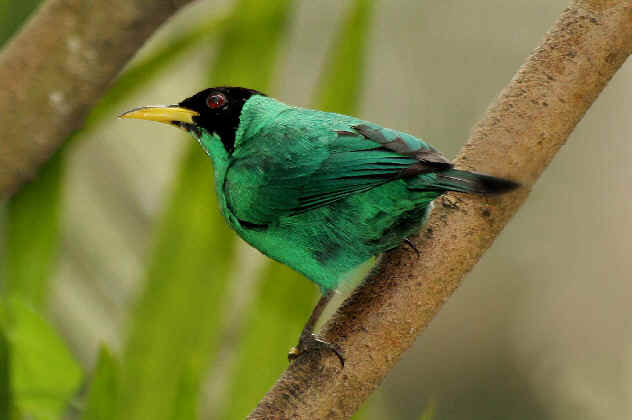
The Green Honeycreeper was one
of the birds
during our Feb '06 tour in southern Costa Rica & adjacent Panama.
This photo is of a male.
Also with green, below, is a Urania Moth,
photographed during this tour in southern Costa Rica.
Uraniinae moths can be confused with swallowtail butterfleis,
since they are large, very colorful, tailed,
diurnal, and flower-loving.
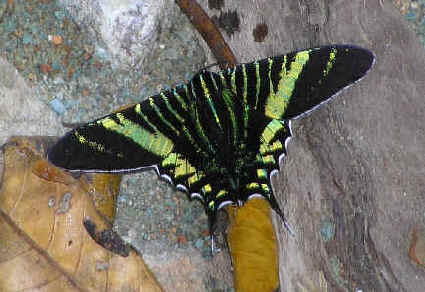
Links:
List of Birds during our Costa Rica & Panama Tours - February '06
Cumulative list of Birds during FONT Costa Rica Tours
Cumulative List of Birds during FONT Panama Tours
Upcoming FONT Birding & Nature Tours in Costa Rica & Panama
The following account written by Armas Hill, leader of the tour:
This birding & nature tour, February
10-18, 2006, included portions of two countries. We were in the
highlands and on the Pacific slope and in the Pacific lowlands of Costa
Rica. In adjacent Panama, we were
in the highlands and lowlands of the Chiriqui, the westernmost province in that
country. All of these areas were not only enjoyable places to be, but also great
places to bird.
Of the 267 species of birds found during this tour, 238 were in Costa Rica. 107
were in Panama during the 2 days that were were there. 78 of the 267 species
were found in both countries, while 29 species were found in Panama alone. In
that last category were:
the Veragua Parakeet (an isolated population that has been considered
a subspecies of the Brown-throated Parakeet of northern South
America),
the Veraguan Mango (which was considered part of the Green-breasted
Mango); we saw a female on a nest,
and the White-throated Mountain-gem (closely related to other mountain-gems,
particularly the Gray-tailed Mountain-gem that we also saw - in
Costa Rica).
Other birds that during this tour we found only in Panama included:
Pied-billed Grebe
Least Grebe
Anhinga
Black-crowned Night-Heron
Snail Kite (this species is rare in Panama)
Mangrove (or Pacific) Black Hawk
Great Black Hawk
Peregrine Falcon
American Oystercatcher
Black-bellied Plover
Killdeer
Black-necked Stilt
Whimbrel
Sanderling
Groove-billed Ani (in the Chiriqui highlands)
White-tailed Nightjar (a wonderful find, seen at rest during the
day)
Violet Sabrewing
Brown Violetear
Ruby-throated Hummingbird (a rarity in Panama)
Red-faced Spinetail (in the Chiriqui highlands)
Barred Antshrike
Red-capped Manakin (a gem to see - in a forest by the Pacific
beach)
Yellow-bellied Flycatcher (in the Chiriqui highlands)
Barn Swallow (how could it be that there were none of these
during our 5 days in Costa Rica)
Cliff Swallow (a few with the Barn Swallows)
Eastern Meadowlark
From the likes of Black-bellied Plover, Whimbrel, and Sanderling,
you can see that we were at a beach in Chiriqui. It was a beautiful one, with
surf and sand for miles, without many people and with many birds. It's
interesting that of the species in the list above, and seen along that beach,
was new for FONT in Central America, the American Oystercatcher. That's
not an easy feat, as there have been numerous FONT tours in Central America, in
Costa Rica, Panama, Guatemala, Honduras, and Belize. And our cumulative list is
not short. The American Oystercatcher in Panama became bird # 931.
This was our 27th birding & nature tour in Costa Rica. Prior to it, our
cumulative total of birds for the country was 684.
During this February '06
tour, 1 new species was added to that CR list, the Southern Lapwing. 2 of
them were seen in a pasture south of Golfito; they appeared to be on territory.
Maybe now the Southern Lapwing is a nesting bird in Costa Rica. The Southern
Lapwing is not in the book "A Guide to the Birds of Costa Rica" by F.
Gary Stiles & Alexander Skutch, published in 1989. The species, common to
abundant in much of South America, has been spreading north. In Panama, it has
been of regular occurrence north to the Canal Basin. We've seen it, in recent
years, in Panama as far west (or north) as the Chiriqui lowlands. Where it
occurs in the Panama Canal Basin, it's often with Wattled Jacanas. In the
Chiriqui lowlands, it was with Northern Jacanas, as it was in the
partially wet Costa Rican pasture south of Golfito. Another bird from the south,
that's been spreading north, was also in that pasture, the Red-breasted
Blackbird.
That's part of the fun of birding in southern Costa Rica. There's the chance of
seeing something a bit unexpected, as more-southerly birds are moving in. During
other tours in that region of southern Costa Rica, we've seen Savanna Hawk
and Pearl Kite, two other species expanding northward.
Years ago, that's
where the Yellow-headed Caracara was first seen in Costa Rica. Now it's
seen in open, deforested areas throughout the country, north to Nicaragua.
Another "part of the fun" of birding in southern Costa Rica is that it
is a bit of "the way it was". For those of us who have birded in Costa
Rica for years (I have since 1978), we've seen a lot of changes. Notable
among them are changes of habitats, and that there are now many more people (ecotourists
and others) who visit. Costa Rica is, for a few reasons, a great place to
visit for nature. Varied habitats are close to each other. There are good
accommodations. But there's also a price in that it's now a special treat to
find a place that's not, as it were, "on the beaten path". In southern
Costa Rica, that can more readily be done. For example, we traveled, during our
Feb '06 tour, along a dirt road, not often traveled, into the northern Osa
Peninsula, where among the birds that we encountered, there were Scarlet
Macaws in flocks, King Vultures soaring over a ridge, and both Great
and Little Tinamous calling a dusk in the woods. Earlier, along that
road in the morning, Three-wattled Bellbirds were giving their loud calls
in the trees.
And yet another "good part" of birding in southern Costa Rica is that
there are a number of species to be found there with restricted ranges, only in
that portion of Costa Rica and in adjacent Panama. They include:
Chiriqui (or Rufous-breasted) Quail-Dove
Costa Rican Swift (has been considered part of the Band-rumped
Swift that's common further south in Panama)
Charming Hummingbird (also called the Beryl-crowned Hummingbird,
closely related to the Bue-chested Hummingbird of Costa Rica's
Caribbean slope and further south in Panama)
Garden Emerald (was part of the Fork-tailed Emerald, now
"split" into 4 or 5 species)
Baird's Trogon
Golden-naped Woodpecker
Black-hooded Antshrike
Riverside Wren
Chiriqui Yellowthroat (has been considered part of what has been the Masked
Yellowthroat of South America)
and the Black-cheeked Ant-Tanager, which is even more localized than
the others here, as it is restricted to part of the region of the Golfo Dulce
("Sweet Gulf") in Costa Rica. The species is one of the handful of
species (4) endemic to Costa Rica.
All of the birds in this paragraph were found during our February '06 tour in
Southern Costa Rica & adjacent Panama.
A group of birds that has become easier to observe during recent years in Costa
Rica & Panama has been the hummingbirds. To a large extent that's due
to there being more hummingbird feeders, particularly at lodges, where they can
be readily observed. During our Feb '06 tour in southern Costa Rica and Panama,
22 species of hummingbirds were seen. Some were at feeders and others were in
their natural settings, usually feeding a flowering bushes or trees. Our
hummingbirds during the tour follow (noting the country where seen, Costa
Rica (CR), Panama (PN) and if naturally (n) or at feeders
(f)):
Band-tailed Barbthroat (CR) (n)
Bronzy Hermit (CR) (n)
Western Long-tailed (or Long-billed) Hermit
(CR) (n)
Scaly-breasted (or Cuvier's) Hummingbird
(CR) (n)
Violet Sabrewing (PN) (f)
Brown Violetear (PN) (n)
Montane Violetear (the southern population of the Green
Violetear) (CR,PN) (f,n)
Veraguan Mango (formerly part of the Green-breasted Mango)
(PN) (n)
Garden Emerald (CR) (n) (formerly part of the Fork-tailed
Emerald, that has been "split" into 4 or 5 species throughout
Central America; this is the southernmost of the "splits".)
Fiery-throated Hummingbird (CR) (f,n) (in the high mountains,
restricted to southern Costa Rica & western Panama) (This extraordinarily
beautiful hummingbird has been said to be declining in recent years, possibly
due to global warming.)
Blue-throated Goldentail (also called Blue-throated
Sapphire) (CR) (n)
Charming Hummingbird (also called the Beryl-crowned Hummingbird)
(CR) (n)
Snowy-bellied Hummingbird (CR,PN) (f,n) (This species is
more common in Panama.)
Rufous-tailed Hummingbird (CR) (n)
White-throated Mountain-gem (PN) (f)
Gray-tailed Mountain-gem (CR) (f)
Green-crowned Brilliant (CR) (f,n)
Magnificent Hummingbird (CR) (f,n)
Magenta-throated Woodstar (CR) (f)
Ruby-throated Hummingbird (PN) (n) (as already noted, rare in
Panama)
Scintillent Hummingbird (CR) (f) (This is Costa Rica's
smallest bird.)
Volcano Hummingbird (CR) (f) (On different mountains in
Costa Rica, subspecies of this bird have different colored gorgets. The male of
the subspecies we saw in southern Costa Rica, has one that's purplish-gray,
rather like flowing lava from a volcano.)
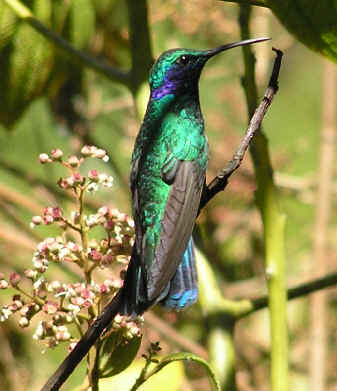
Green Violet-ear
(Photograph taken during the FONT tour in Costa Rica,
in February 2006, by Rosemary Lloyd)
During other FONT
tours in southern Costa Rica there were even more hummingbirds, such as
the White-tipped Sicklebill and the White-crested Coquette. In
all, in Costa Rica, there are 45 species of hummingbirds. All of these have been
found during FONT Costa Rica tours over the years. Some are only in the northern
part of the country. Others are most common on the Caribbean side. Two species
of hummingbirds endemic to Costa Rica are the Coppery-headed Emerald and
the Mangrove Hummingbird. If one takes the time to sit for a while and
watch hummingbirds feed and fly, it's a really a pleasure. How such fascinating
little birds can have, in good light, such spectacular colors, is nearly
unbelievable.
A number of the hummingbirds just mentioned occur in the mountains of
southern Costa Rica. Those high mountains when there's good weather (as we
had) can be a beautiful place to be, with some nice birds to see. Among
those that we saw were the Spangle-cheeked Tanager, Blue-and-gold Tanager,
Sooty-capped Bush-Tanager, many Ruddy Treerunners, the Zelodonia
(that's also been called the Wrenthrush, and now is considered
an aberrant warbler), and another warbler that's a wonderful bird to see,
the dapper Collared Redstart, called the "amigo de hombre" (or
"friend of man") due to its tameness.
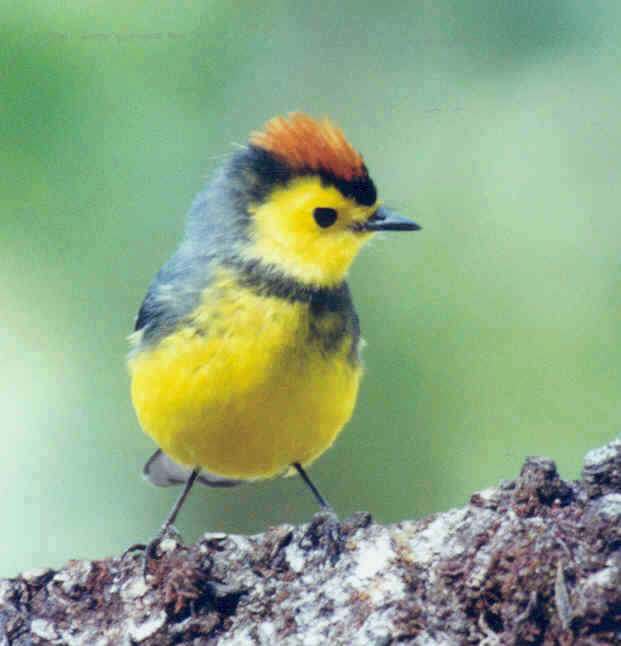
Collared Redstart
In addition to the
colorful Fiery-throated Hummingbird, already referred to, we also saw in
the highlands the Flame-throated Warbler, another attractive bird. We saw
2 species of Silky-Flycatchers (not true flycatchers,
but more closely related to waxwings), the Black-and-Yellow
and the Long-tailed. Also nice to see in the high country was the Barred
Hawk, and flocks of Sulphur-winged Parakeets. At about our highest
point (and in fact by the highest point along the entire Pan American
Highway) we saw Volcano Juncos, and we enjoyed a trio of Finches:
the Peg-footed, the Large-footed, and the Yellow-thighed.
Tanagers, and some of their close relatives, are a colorful lot. During
the days we were based in the Coto Brus Valley we saw some of their best colors
in a nice cast of those birds, including: Silver-throated,
Golden-hooded, Bay-headed, and Speckled Tanagers, in addition to the
more-widespread Cherrie's (formerly Scarlet-rumped) Tanager.
It's a common bird, the Cherrie's Tanager, in southern Costa Rica on the
Pacific side. It's not so, oddly, in western Panama. Also in the colorful cast
of birds in Coto Brus were: Thick-billed Euphonia, Red-legged and Green
Honeycreepers, and the Lance-tailed Manakin. Some visitors from the
north also added some color, notably Baltimore Oriole, Rose-breasted
Grosbeak, Western and Summer Tanagers, and some Warblers such
as: Magnolia, Chestnut-sided, Bay-breasted, Canada, and Mourning.
One of our favorite places that we visited during the Feb '06 tour in southern
Costa Rica was the La Amistad National Park, a large wild area along the
Continental Divide in both Costa Rica and Panama. The park can be difficult to
enter, as the dirt roads ascending into the mountains are rough. We did on a
4-wheel drive truck, with an incredible driver. The forest was magnificent.
Given more time, more birds and animals can be found, but we did see, in
addition to a number of birds just mentioned in the last paragraph, some good
ones, such as the Pale-billed Woodpecker (in the same genus as the
Ivory-billed Woodpecker), the Black-banded Woodcreeper (only the
3rd time for us in 27 Costa Rica tours), and the White-whiskered Puffbird
(also called the White-whiskered Softwing). Whatever it's
called, it sits still. High in the trees were what have been called the Chestnut-mandibled
Toucan. New taxonomy now says that this large bird is now conspecific with
the Black-mandibled Toucan of South America. In a rock in a rushing
stream there was a marvelous Sunbittern. That bird is not conspecific
with anything. It's unique, in its own family. Earlier in the day, in a pond, we
saw some Masked Ducks. Yes, it was a good day.
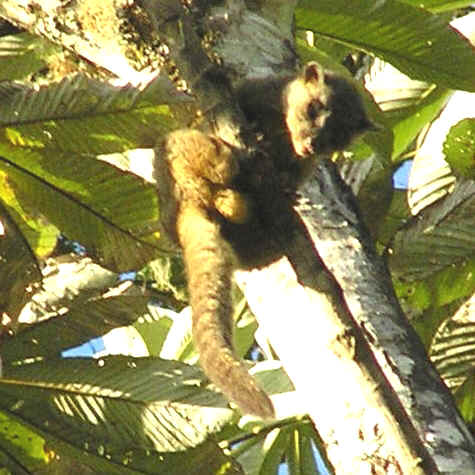
A Kinkajou photographed in
the forested mountains of southern Costa Rica
during the FONT tour in February 2006.
(Photo by Rosemary Lloyd)
Mammals that we saw at La Amistad National Park included the White-faced Capuchin Monkey and Kinkajou. The latter, normally nocturnal, was seen high in a tree during the day, apparently feeding. Other wildlife included the Morelet's Crocodile, Spectacled Caiman, and Green Iguana. And we saw a wonderful assortment of butterflies and moths (photographs of some taken during the tour are in our Central America Butterfly List, elsewhere in this website).
Yes, it was a good tour, during a week in southern Costa Rica and western Panama in February 2006.